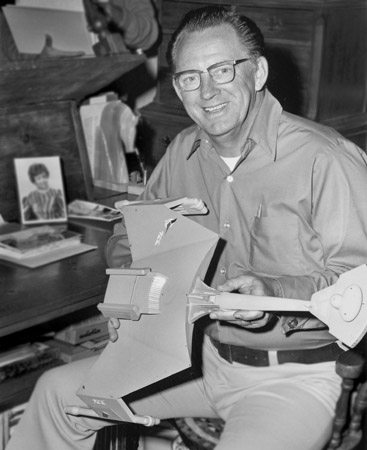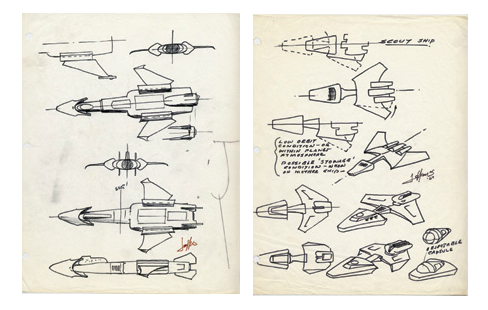This is the second in a series of posts tracing the storied path of the Leif Ericson, a spaceship designed in 1968 whose afterlife has carried it through a number of incarnations in different media formats – most notably, plastic. Previous posts can be found here.
Viewing the Leif Ericson as the expression of Matt Jefferies’s singular engineering sensibility is pleasing for at least two reasons. First, in crediting the ship to the work of a “great man” of production design (who himself worked under the direction of another, that Great Bird of the Galaxy Gene Roddenberry) it scratches our auteurist itch—one specific to modes of fandom oriented toward behind-the-scenes makers such as special-effects artists. Second, it invites us to tie the Ericson to a larger fictional system, the storyworld of Star Trek: even if never directly seen or mentioned in the original series, maybe the Ericson was out there regardless, plying the spaceways alongside the Enterprise and other Starfleet vessels.
Both of these satisfactions are, in their way, ideological lures: means of extracting pleasure from the fantasy operations of capitalism. We come nearer the truth, or at least a more complete picture, if we see the Ericson as the product of an industrial relationship between two arms of mass culture: television and toys. For in 1968, the Leif Ericson made its first appearance in public not on screen but in the material form of a plastic model kit.
The Michigan-based manufacturer AMT had enjoyed a mutually beneficial symbiosis with Star Trek since before the show’s premiere, contracted by Desilu—the studio where Roddenberry developed Trek—to build technological exotica as needed for the series. Although the company’s name, AMT, stood for Aluminum Model Toys, its capabilities extended beyond the making of cheap playthings into the fabrication of large commercial items. As detailed on Memory Alpha, the need to make “finished display pieces … for marketing purposes” led AMT to start the Speed and Custom Division Shop, a subsidiary “to build both full-scale and scaled automobile mockups … to promotional ends, as well as to manufacture the templates or masters in order to construct the molds from which the parts for their model kits were extracted or cast.” A third axis, extending outward from these coordinates of showroom spectacle and mass-produced consumer item, connected the items AMT built for Trek: objects ranging from studio miniatures to full-sized sets to be inhabited by actors.
These production artifacts were at one and the same time components of an invented future, simultaneously split and joined by the ontological dividing lines of camera lens, celluloid splice, cathode-ray tube. Take for example the Galileo shuttlecraft: AMT built it as a studio model to be filmed against a bluescreen and matted onto backgrounds of starry space, but also made a full-sized version of the ship’s interior. Episodes like the first season’s “Galileo 7”—written in part to showcase the spacecraft—married together exterior and interior, constructing for audiences a screen reality through the simple yet profound magic of a televisual edit.
To be continued …


